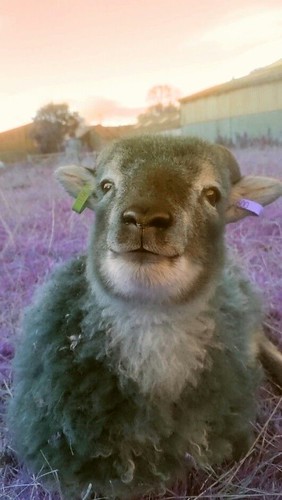 |
| Ready for a new rare breed Adventure yet? |
It’s been a while since we had a rare sheep breed adventure so why not have one now? You may know I am a huge Outlander fan and I am so happy that “droughtlander” is almost over with a new season starting mid September based on Diana Gabaldon’s “Voyager” book in the Outlander series.
This book takes place in Jamaica and in the United States so it is a bit of a different scenario and has different colours, maybe a bit steamier seeing the hot and humid climate there ..lol
Anyhoo, I have added a few very interesting rare sheep together to connect the adventure with the Voyager adventure and I do hope you like it. I will tell you the story of all the sheep featured in this blend with a little history AND you can see the colour scheme I have come up with based on the book and the stills I have seen of the season coming up.
Please have a read and then when you get to the sign up section you can see the inspiration photos for the colourway the tops and the batts will be dyed in.
You have the choice to buy dyed batt(s) with or without silver Angelina and handdyed tops or – why not both? Yes, I am being evil, I know…lol!
The sheep breed at the centre of attention is the Scottish Soay sheep and then , because “Voyager” the book takes us to Jamaica, I could not help myself and source Jamaican sheep breeds: the Criollo and the St Elizabeth White. Have a fun read !
Soay Sheep: The rare sheep breed in the spot light is the very special soay sheep of the Scottish Islands of St Kilda and Hirta ! It is a very, very rare ancient breed, with roots going back all the way to the bronze age !
The Isle of Soay, a name derived from the Norse word for Sheep Island, is near the North West corner of Hirta. A very dangerous, narrow channel and sea stacks separate the two. Soay is extremely difficult to access due to its steep rocky cliffs, boulder fields and lack of anchorage.
It can only be approached when seas are very calm and quickly changing weather can make getting off the island nearly impossible, it is the least accessible of all the islands in the archipelago. It is believed that sheep have probably inhabited Soay since the Bronze Age and are the descendants of the very first domesticated sheep which populated northern Europe. They are the most primitive surviving livestock breed in the UK.
The sheep on Soay Island were not owned by the St. Kildans of Hirta, but instead by the islands various lairds (landlords). Their feudal tenants were allowed to annually collect fleece from these sheep and were occasionally permitted to take an animal, for a fee, to kill for special occasions. While Soay is somewhat larger (244 acres) than its neighbour Boreray (189 acres) Soay supports fewer animals per acre because its high central plateau is a marshy bog with little vegetation suitable to grazing sheep.
This book takes place in Jamaica and in the United States so it is a bit of a different scenario and has different colours, maybe a bit steamier seeing the hot and humid climate there ..lol
Anyhoo, I have added a few very interesting rare sheep together to connect the adventure with the Voyager adventure and I do hope you like it. I will tell you the story of all the sheep featured in this blend with a little history AND you can see the colour scheme I have come up with based on the book and the stills I have seen of the season coming up.
Please have a read and then when you get to the sign up section you can see the inspiration photos for the colourway the tops and the batts will be dyed in.
You have the choice to buy dyed batt(s) with or without silver Angelina and handdyed tops or – why not both? Yes, I am being evil, I know…lol!
The sheep breed at the centre of attention is the Scottish Soay sheep and then , because “Voyager” the book takes us to Jamaica, I could not help myself and source Jamaican sheep breeds: the Criollo and the St Elizabeth White. Have a fun read !
Soay Sheep: The rare sheep breed in the spot light is the very special soay sheep of the Scottish Islands of St Kilda and Hirta ! It is a very, very rare ancient breed, with roots going back all the way to the bronze age !
The Isle of Soay, a name derived from the Norse word for Sheep Island, is near the North West corner of Hirta. A very dangerous, narrow channel and sea stacks separate the two. Soay is extremely difficult to access due to its steep rocky cliffs, boulder fields and lack of anchorage.
It can only be approached when seas are very calm and quickly changing weather can make getting off the island nearly impossible, it is the least accessible of all the islands in the archipelago. It is believed that sheep have probably inhabited Soay since the Bronze Age and are the descendants of the very first domesticated sheep which populated northern Europe. They are the most primitive surviving livestock breed in the UK.
The sheep on Soay Island were not owned by the St. Kildans of Hirta, but instead by the islands various lairds (landlords). Their feudal tenants were allowed to annually collect fleece from these sheep and were occasionally permitted to take an animal, for a fee, to kill for special occasions. While Soay is somewhat larger (244 acres) than its neighbour Boreray (189 acres) Soay supports fewer animals per acre because its high central plateau is a marshy bog with little vegetation suitable to grazing sheep.
.jpg) |
| the Island of sheep |
St. Kilda is a group of islands which are the most westerly part of Scotland; they are 41 miles from Benbecula in the Outer Hebrides and 110 miles from the Scottish mainland.
This archipelago consists of four small islands and some large rocky outcrops which are all that remains of a long extinct volcano. The islands are remote and spectacular with the highest cliffs in the UK and are the home to large colonies of seabirds.
There is evidence that the main island Hirta has been inhabited for thousands of years but the habitation might not have been continuous. There is also evidence of human activity on the other three islands of Dun, Soay and the more remote Boreray.
The island of Soay has been the home of the most primitive form of domestic sheep in the UK for thousands of years which have remained as a relic of early domestication due to isolation and inaccessibility. The islanders, known as the St. Kildans were the tenants of various owners of St. Kilda, they had limited resources other than the vast seabird colonies. They caught thousands of these birds and used their feathers and extracted their oil as a currency to pay their rent and to buy meagre provisions.
The most remote island of the archipelago is Boreray which was used by the St. Kildans to harvest sea birds and their eggs and also keep a reserve flock of their unique domestic sheep, now known as Boreray Sheep.
As more communications with the mainland improved the life of the islanders changed, they were subject to diseases brought by contact with outsiders which caused heavy mortality. There was movement to the mainland and immigration to other parts of the world until in 1930 the population became so low with so few able bodied men they could no longer sustain themselves and they chose to leave. In 1957, the entire archipelago was bequeathed to the National Trust for Scotland and has been in their ownership and protection ever since.
This archipelago consists of four small islands and some large rocky outcrops which are all that remains of a long extinct volcano. The islands are remote and spectacular with the highest cliffs in the UK and are the home to large colonies of seabirds.
There is evidence that the main island Hirta has been inhabited for thousands of years but the habitation might not have been continuous. There is also evidence of human activity on the other three islands of Dun, Soay and the more remote Boreray.
The island of Soay has been the home of the most primitive form of domestic sheep in the UK for thousands of years which have remained as a relic of early domestication due to isolation and inaccessibility. The islanders, known as the St. Kildans were the tenants of various owners of St. Kilda, they had limited resources other than the vast seabird colonies. They caught thousands of these birds and used their feathers and extracted their oil as a currency to pay their rent and to buy meagre provisions.
The most remote island of the archipelago is Boreray which was used by the St. Kildans to harvest sea birds and their eggs and also keep a reserve flock of their unique domestic sheep, now known as Boreray Sheep.
As more communications with the mainland improved the life of the islanders changed, they were subject to diseases brought by contact with outsiders which caused heavy mortality. There was movement to the mainland and immigration to other parts of the world until in 1930 the population became so low with so few able bodied men they could no longer sustain themselves and they chose to leave. In 1957, the entire archipelago was bequeathed to the National Trust for Scotland and has been in their ownership and protection ever since.
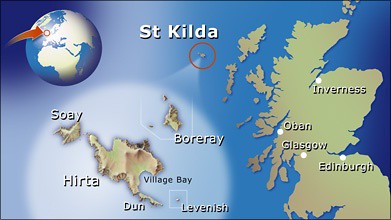 |
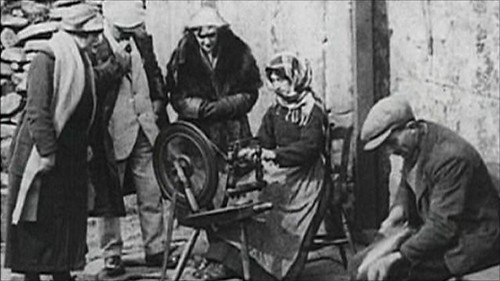 |
| Tourists flocking around a spinner showing them spinning soay (1900s) |
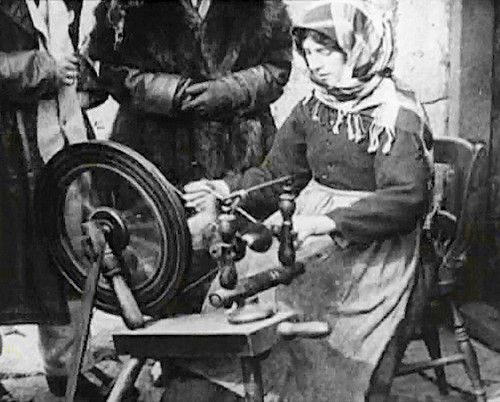 |
| close up |
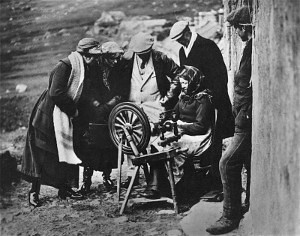 |
| spinning magic |
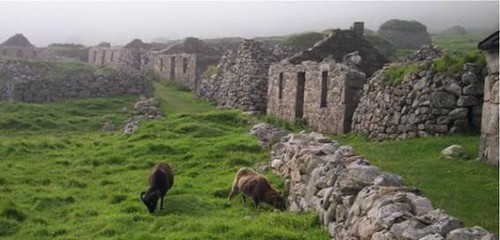 |
| now the same street is deserted... except for the grazing soay sheep that have been there for centuries |
The animals on Soay have never been managed and lived feral on the island for thousands of years, no one is certain how long or how they got there.
There are dark and blond sheep with some ewes being horned and many others polled (no horns) or scurred (small or misshaped horns). Over recent centuries some animals have been taken from Soay to estates on the mainland of the UK. Over a period of time starting in 1932, after St. Kilda had been evacuated and sold, 107 animals were captured and transferred to the vacant pastures of Hirta.
This was a significant number taken from the small population on Soay Island. Today flocks survive in both locations.
Visitors to St Kilda will immediately notice three striking features of the sheep.
First, Soay sheep are tiny. In August, mature females average around 24kg in weight while mature males are around 38kg, making them about one third the size of most modern domestic sheep.
You can sign up for the tops and batts or…you can choose both ! However, I only have a very very limited amount of this rare sheep breed blend adventure available!!
It is super special, it is luxurious and it is super gorgeous. It is easy to draft, silky smooth, with a bit of lustre and an amazing drape.


There are dark and blond sheep with some ewes being horned and many others polled (no horns) or scurred (small or misshaped horns). Over recent centuries some animals have been taken from Soay to estates on the mainland of the UK. Over a period of time starting in 1932, after St. Kilda had been evacuated and sold, 107 animals were captured and transferred to the vacant pastures of Hirta.
This was a significant number taken from the small population on Soay Island. Today flocks survive in both locations.
Visitors to St Kilda will immediately notice three striking features of the sheep.
First, Soay sheep are tiny. In August, mature females average around 24kg in weight while mature males are around 38kg, making them about one third the size of most modern domestic sheep.
 |
Second, they are highly variable in appearance. While many Soays have the ‘classic’ Soay coat colour, which we call ‘dark wild’ (with ‘wild’ being short for ‘wildtype’ the coat pattern that features a light belly and rump patch), we recognise three other varieties (‘dark self’, ‘light wild(type)’ and ‘light self’ (where ‘self’ refers to ‘self-coloured’ – a coat pattern with the same colour all over including belly and rump patch).
Studies have shown that the dark/light colouration is due to a gene called tyrosinase-related protein 1, or TYRP1 which is on sheep chromosome 2 and genetically dark is dominant to light, while the wild/self colouration is due to the locus Agouti on sheep chromosome 13 and wild is dominant to self.
There are however, very cute Soay sheep with white patches as well. (note: in angora rabbits for example there is the agouti on chromosome 13 as well, making the off spring able to have all different colours. Agouti is a gorgeous thing to have in the gene pool !).
Studies have shown that the dark/light colouration is due to a gene called tyrosinase-related protein 1, or TYRP1 which is on sheep chromosome 2 and genetically dark is dominant to light, while the wild/self colouration is due to the locus Agouti on sheep chromosome 13 and wild is dominant to self.
There are however, very cute Soay sheep with white patches as well. (note: in angora rabbits for example there is the agouti on chromosome 13 as well, making the off spring able to have all different colours. Agouti is a gorgeous thing to have in the gene pool !).
 |
The University of Edinburg is doing a lot of research on these soay sheep because it offers them a very good insight in the ecology and the evolution of the species. A count of the whole of Hirta’s Soay sheep population has been conducted most years since 1952 by the same method.
It was these counts that revealed that Soay sheep on St Kilda have rather unusual population dynamics. The Soay population rises to maxima and then crashes, at irregular intervals. It is this population dynamic behaviour that makes Soay sheep so interesting for ecologists. The sheep exhibit a phenomenon known as overcompensatory density dependence, in which their population never reaches equilibrium.
The population growth is so great as to exceed the carrying capacity of the island, which eventually causes a dramatic population crash, and then the cycle repeats. For example, in 1989, the population fell by two thirds within 12 weeks !!
In brief, it became clear that the population dynamics of Soay sheep happen because virtually all mature females conceive each year, regardless of density, and as a result, the population can increase in one breeding season to a size which greatly exceeds the winter carrying capacity, when it may crash. Crashes are more likely to occur when there is bad winter weather, and when the population contains a large proportion of vulnerable sheep such as lambs and males. The population then increases again, over several years, before another crash.
As ecological research proceeded, it became clear that the Soay sheep population also offers remarkable opportunities for understanding the progress of natural selection and evolution in real time. Population crashes are a period of intense selection, could they have anything to do with the maintenance of genetic variation, for example in coat colour and horn type? Does the low life expectancy of most individuals select for early reproductive effort? Likewise, the population dynamics research inspires numerous questions about the relationship between the sheep and their biotic environment, including the plants on which they feed and the parasites. The Soay sheep have short tails and naturally shed their wool, which can be hand plucked (called rooing) in the spring and early summer. About one kilogram of wool can be obtained from each animal per year.
It was these counts that revealed that Soay sheep on St Kilda have rather unusual population dynamics. The Soay population rises to maxima and then crashes, at irregular intervals. It is this population dynamic behaviour that makes Soay sheep so interesting for ecologists. The sheep exhibit a phenomenon known as overcompensatory density dependence, in which their population never reaches equilibrium.
The population growth is so great as to exceed the carrying capacity of the island, which eventually causes a dramatic population crash, and then the cycle repeats. For example, in 1989, the population fell by two thirds within 12 weeks !!
In brief, it became clear that the population dynamics of Soay sheep happen because virtually all mature females conceive each year, regardless of density, and as a result, the population can increase in one breeding season to a size which greatly exceeds the winter carrying capacity, when it may crash. Crashes are more likely to occur when there is bad winter weather, and when the population contains a large proportion of vulnerable sheep such as lambs and males. The population then increases again, over several years, before another crash.
As ecological research proceeded, it became clear that the Soay sheep population also offers remarkable opportunities for understanding the progress of natural selection and evolution in real time. Population crashes are a period of intense selection, could they have anything to do with the maintenance of genetic variation, for example in coat colour and horn type? Does the low life expectancy of most individuals select for early reproductive effort? Likewise, the population dynamics research inspires numerous questions about the relationship between the sheep and their biotic environment, including the plants on which they feed and the parasites. The Soay sheep have short tails and naturally shed their wool, which can be hand plucked (called rooing) in the spring and early summer. About one kilogram of wool can be obtained from each animal per year.
 |
| one day old Soay lamb in camouflage |
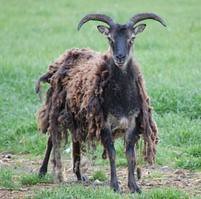 |
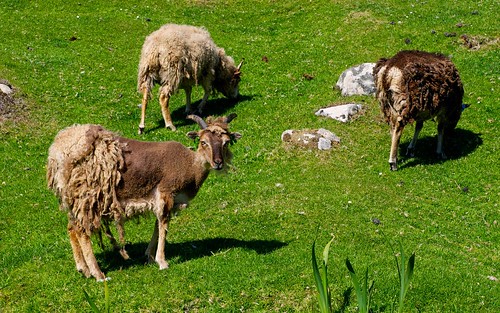 |
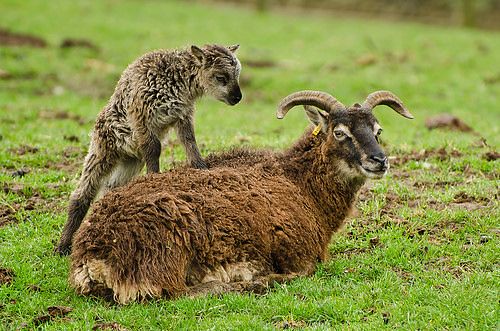 |
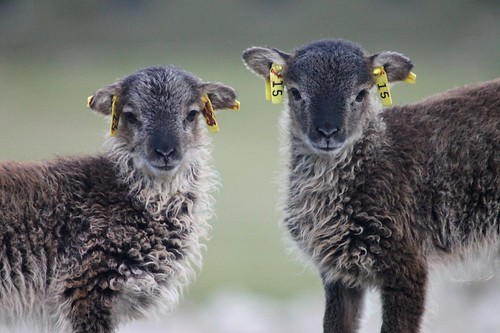 |
This breed has extremely fine fleece and it is difficult to distinguish an outer coat. This is a clear indication that the Soay are indeed the product of a domesticated breed in prehistoric times.
The breed also lacks the flocking instinct of many breeds. Attempts to work them using sheep dogs result in a scattering of the group: no use entering them at the Bendigo sheep and wool show dog trials: it would be extremely frustrating for the sheep and dogs. They obviously are the rebels among sheep !
The breed also lacks the flocking instinct of many breeds. Attempts to work them using sheep dogs result in a scattering of the group: no use entering them at the Bendigo sheep and wool show dog trials: it would be extremely frustrating for the sheep and dogs. They obviously are the rebels among sheep !
 |
| Soay sheep fleece |
These sheep are extremely special and it inspired me to do a rare sheep breed adventure blend named Voyager, after the 3rd book in the Outlander series by Diana Gabaldon and upcoming 3rd season of the tv series.
The colours of the soay sheep and the blend actually remind me of the feel and look that the Outlander series have created: all types of gorgeous caramel browns like, Jamie's hair.
Jamaican Sheep !
Voyager takes place in Jamaica and Georgia in the United States, so I have been on the look out for some Jamaican sheep fibre to add to the mix. Not an easy task!
I did find that there are so called “Criollo” sheep and St Elizabeth White Sheep. There are not a lot of woolly sheep on Jamaica and the sheep farming only recently started to become more popular but just to get a place in the meat market. In tropical America there are two quite different types of sheep: the woolen sheep and the hair sheep from Africa, that are fibre less really and just bred for meat, but are excellent for the tropical climate in Jamaica.
There are some “woolen” sheep in the highlands like the Criollo, which originates from the Churro imported from Spain by the Spanish Conquistadores during the period 1548 to 1812. It is a small to medium-sized animal producing a small quantity of wool, which is important for the cottage wool industry. Colour is often white but coloured animals are common. The Criollo, is the principal breed in Mexico, Guatemala, Nicaragua, Colombia, Venezuela, Guyana, Ecuador, Peru and Bolivia. There are also small populations in Haiti and the Dominican Republic.
There is also another small population of woolen sheep in Jamaica, called St. Elizabeth sheep, which also has a European origin but it is not known when or from where their ancestors were introduced. They have a very nice white fleece, that is appr. 23 to 30 micron.
Because these two rare breeds are less fine than the Soay I have added a bit more cashmere and English Angora Bunny fleece to make it super next to skin soft. You will be surprised how this blend drapes once spun.
Jamaican Sheep !
Voyager takes place in Jamaica and Georgia in the United States, so I have been on the look out for some Jamaican sheep fibre to add to the mix. Not an easy task!
I did find that there are so called “Criollo” sheep and St Elizabeth White Sheep. There are not a lot of woolly sheep on Jamaica and the sheep farming only recently started to become more popular but just to get a place in the meat market. In tropical America there are two quite different types of sheep: the woolen sheep and the hair sheep from Africa, that are fibre less really and just bred for meat, but are excellent for the tropical climate in Jamaica.
There are some “woolen” sheep in the highlands like the Criollo, which originates from the Churro imported from Spain by the Spanish Conquistadores during the period 1548 to 1812. It is a small to medium-sized animal producing a small quantity of wool, which is important for the cottage wool industry. Colour is often white but coloured animals are common. The Criollo, is the principal breed in Mexico, Guatemala, Nicaragua, Colombia, Venezuela, Guyana, Ecuador, Peru and Bolivia. There are also small populations in Haiti and the Dominican Republic.
There is also another small population of woolen sheep in Jamaica, called St. Elizabeth sheep, which also has a European origin but it is not known when or from where their ancestors were introduced. They have a very nice white fleece, that is appr. 23 to 30 micron.
Because these two rare breeds are less fine than the Soay I have added a bit more cashmere and English Angora Bunny fleece to make it super next to skin soft. You will be surprised how this blend drapes once spun.
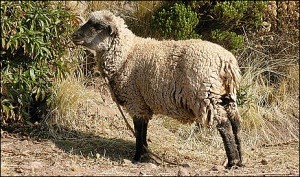 |
| The Criollo Sheep in Jamaica. |
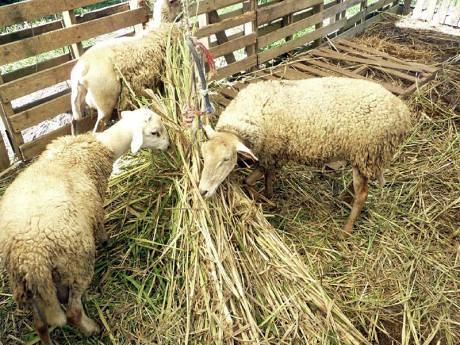 |
| The St Elizabeth White Sheep, carelessly munching away on some nice fresh treats |
You can sign up for the tops and batts or…you can choose both ! However, I only have a very very limited amount of this rare sheep breed blend adventure available!!
It is super special, it is luxurious and it is super gorgeous. It is easy to draft, silky smooth, with a bit of lustre and an amazing drape.
Below are all the details and the mood board for the colourway of the rare sheep breed adventure called Voyager!
Enjoy !
Enjoy !
IxCHeL Rare Sheep Breed Fibre Adventure “VOYAGER”
Sign up
Voyager Batts and Voyager Tops!
Sign up by sending me an email or PM to receive your Voyager batts and tops, Shipping date: mid to end October 2017 in a very special super limited release !
Here’s your chance to spin some amazingly special batts and tops with a blend of :
very RARE SHEEP BREEDS !!:
Soay Sheep from Scotland ;
Criollo and St Elizabeth White Sheep from Jamaica
Eco merino
Muga silk
Cashmere
English Angora Bunny very RARE SHEEP BREEDS !!:
Soay Sheep from Scotland ;
Criollo and St Elizabeth White Sheep from Jamaica
Eco merino
Muga silk
Cashmere
The handdyed Voyager batts and tops will be inspired by the mystery and magic of Jamaica and Voyager from the Outlander book series. I will ONLY make enough batts for those who sign in.
Sign in on the Voyager batts and tops will close September 18th OR until the amount that I can make runs out, whichever comes first !!!
Only the ones who sign up for the Voyager Adventurewill have these exclusive IxCHeL Voyager Hand dyed Batts and tops!
the batts will each weigh appr 150 + grams each! AU$38
the tops are a 100g + each ! AU$25
There will only be a very very VERY limited supply!!
You will have to sign up before September 18th!
PM me on Ravelry (ixchelbunny)or facebook (https://www.facebook.com/IxchelYarnsAndFibres/) or Instagram @ixchelbunny or email me
Single, double or combined serves are possible !
I have added “inspiration photos” and the view of the “naked Voyager Jamie” below. Enjoy !
Sign in on the Voyager batts and tops will close September 18th OR until the amount that I can make runs out, whichever comes first !!!
Only the ones who sign up for the Voyager Adventurewill have these exclusive IxCHeL Voyager Hand dyed Batts and tops!
the batts will each weigh appr 150 + grams each! AU$38
the tops are a 100g + each ! AU$25
There will only be a very very VERY limited supply!!
You will have to sign up before September 18th!
PM me on Ravelry (ixchelbunny)or facebook (https://www.facebook.com/IxchelYarnsAndFibres/) or Instagram @ixchelbunny or email me
Single, double or combined serves are possible !
I have added “inspiration photos” and the view of the “naked Voyager Jamie” below. Enjoy !
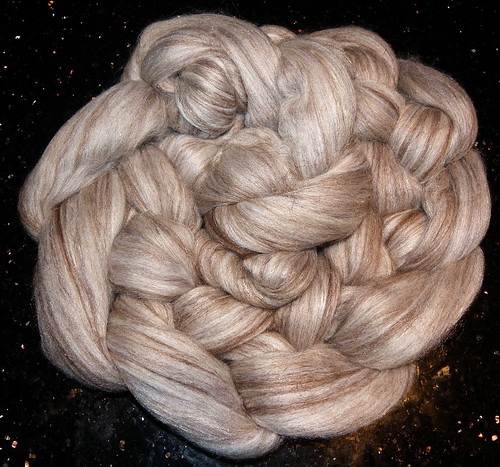 |

 |
Please don't hesitate to contact me at any time if you have any questions okay? Always happy to enable. All my contact details are also to be found at the end of this week’s blog entry.
The New IxCHeL Club sign ups are open as well ! get a monthly fibre and yarn fix surprise : always great blends and colourways only hand dyed for those who are club members !
October, November, December 2017
For all our international club fans there is a possibility to ship all three clubs together to save on postage if you want :-) Just pm me and enquire about the options available.
IxCHeL Fibre Club October, November and December 2017
The subscription is for a period of three months and you will receive one special hand dyed top/roving per month to the value of AU$24 or more
All the tops will be hand dyed and will be especially made for the members of IxCHeL Fibre Club !
Price to join the IxCHel Fibre Club #33 and receive your special hand dyed top :)) for three months (Oct, Nove and Dec) is AU$72 + postage (parcel post or airmail). AND there are good value double serves available !!!
For Australia : single serve $72+$28 postage (parcel post), double serve $136+$28 (save $8) or triple serves $204 (save $12!) + postage
For USA + Canada: single serve AU$72+AU$56 (Airmail) double serve AU$136+AU$56
For UK,Europe, rest of the world: Single serve AU$72+AU$69 (airmail) Double serve AU$136+AU$69
For Asia: Single serve AU$72+AU$50 (airmail) Double serve AU$136+AU$50
If you want to receive a fibre surprise every month then join the IXCHEL FIBRE CLUB #33 now. Numbers are strictly limited ! The Oct 2017 Club is going to be shipped out end of Oct, the November mid November and the December one first week of December. Payment via direct deposit or credit card or paypal. Just PM or email me your details.
Numbers are strictly limited !
The IxCHeL Sock Yarn Clubs October, November and December 2017
Every month for three months (October, November and December 2017) you will receive: enough hand dyed luscious yummy yarn to make a pair of socks or a lush shawl or scarf ofcourse! (the hand dyed yarn will be exclusive for the Ixchelbunny SOCK-IT-TO-ME Yarn CLUB and will range from a sockweight yarn or a 3ply or a 4 ply); Every month a new sock pattern, tips and instructions ! Now is that GOOD or is that GOOD ??!
I will even offer a double serve for those of you who like their socks extra long !
For Australia : single serve $84+$28 postage (parcel post) double serve $140 (= one skein FREE!!!) +$28
For USA + Canada: single serve AU$84+AU$56 (Airmail) double serve $140 (= one skein FREE!!!) +AU$56
For UK,Europe, rest of the world: Single serve AU$84+AU$69 (airmail) Double serve $140 (= one skein FREE!!!) +AU$69
For Asia: Single serve AU$84+AU$45 (airmail) Double serve $140 (= one skein FREE!!!) +AU$45
Payment via direct deposit or credit card or paypal . Just PM or email me your details
By the way: you don’t HAVE to knit socks if you don’t want to.. the hand dyed yarn is amazingly nice for scarves, cowls, beanies and even tops ! Anything goes . The Oct 2017 Club is going to be shipped out end of Oct, the November mid November and the December one first week of December.
IxCHeL Funky Bunny Batt Clubs October, November and December 2017
Here are all the details and just pm me when you have any questions or want to be part of the funky bunny batt club Movement ;-) Welcome to the blingy dark side ;-D
The subscription is for a period of three months and you will receive one special hand dyed funky bunny batt per month to the value of AU$40 or more .
The batts will range in weight from 140grams to 180grams with luxury fibres like camel , angora, cashmere, silk, yak, llama even wallaby and bison and rare sheep breeds !!!! All the batts will be hand dyed and will be especially made for the members of IxCHeL funky bunny Club ! Every month you will receive a HUGE luxury funky bunny batt !
Sign up now and you will receive an Ixchel Hand dyed , super luxurious funky bunny batt for October, November and December 2017.
Price to join the IxCHeL Funky bunny for three months is :
For Australia : $108+$28 postage (parcel post)
For USA + Canada: AU$108+AU$56 (Airmail)
For UK,Europe, rest of the world: AU$108+AU$69 (airmail)
For Asia: AU$108+AU$45 (airmail)
If you want to receive a fibre surprise every month then join the IXCHEL FUNKY BUNNY BATT CLUB now.
Numbers are strictly limited ! The Oct 2017 Club is going to be shipped out end of Oct, the November mid November and the December one first week of December. Payment via direct deposit or credit card or paypal. Just PM or email me
Numbers are strictly limited ! The Oct 2017 Club is going to be shipped out end of Oct, the November mid November and the December one first week of December. Payment via direct deposit or credit card or paypal. Just PM or email me
Please don't hesitate to contact me at any time if you have any questions okay? Always happy to enable. All my contact details are to be found at the end of this week’s blog entry.
Have a fun weekend !!!
Have a fun weekend !!!
Dates to put in your Calendar !!
SEPTEMBER
Sunday 24th of September
Black n Coloured Sheep FIELD DAY in Pakenham! Missing out on Bendigo? THIS is the event to visit !
Pakenham Hall
Corner Henry and John Streets , Pakenham
Enquiries: Steph: 0418 590 333
www.facebook.com/BCSBAA.VIC.SE
Landscape dyes
100g tubs AU$11
250 g tubs AU$26
250 g tubs AU$26
Want to dye your own with easy to use acid dyes? I have been selling these Landscape dyes at my workshops and shows for a long time : They are extremely easy to use and come in great shades.
Just contact me with the name of the colour you are after and I will get right back to you.
Just contact me with the name of the colour you are after and I will get right back to you.
Have a creative week!
Please don't hesitate to contact me at any time if you have any questions okay? : Always happy to enable.
All my contact details are here:
How To Order:
1. You can email me on ixchel at rabbit dot com dot au or ixchelbunny at yahoo dot com dot au
2. Message me on facebook or
3. Message me on www.ravelry.com where I am ixchelbunny.
4. message me on Instagram where I am @ixchelbunny
I will email you right back with all your order details and payment methods.
Any questions? Any custom orders for yarn or dyeing fibre? : Please don’t hesitate to ask! Always happy to enable.
2. Message me on facebook or
3. Message me on www.ravelry.com where I am ixchelbunny.
4. message me on Instagram where I am @ixchelbunny
I will email you right back with all your order details and payment methods.
Any questions? Any custom orders for yarn or dyeing fibre? : Please don’t hesitate to ask! Always happy to enable.
Thank you so much for your help and support !
RABBIT ON !
((hugs))
Charly

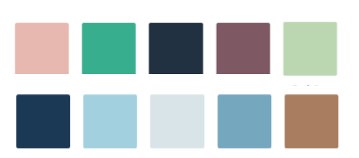






No comments:
Post a Comment